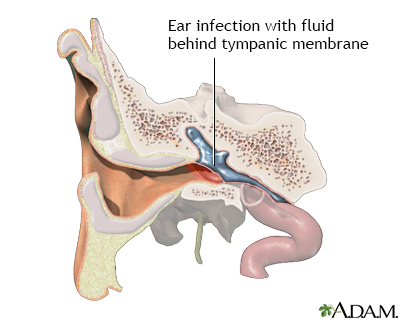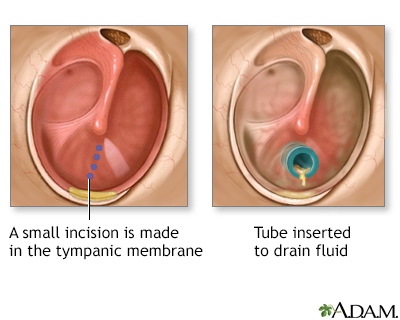Ear tube insertion
Myringotomy; Tympanostomy; Ear tube surgery; Pressure equalization tubes; Ventilating tubes; Otitis - tubes; Ear infection - tubes; Otitis media - tubesEar tube insertion involves placing tubes through the eardrums. The eardrum is the thin layer of tissue that separates the outer and middle ear.
Note: This article focuses on ear tube insertion in children. However, most of the information could also apply to adults with similar symptoms or problems.
Description
While the child is asleep and pain-free (general anesthesia), a small surgical cut is made in the eardrum. Any fluid that has collected behind the eardrum is removed with suction through this cut.
General anesthesia
General anesthesia is treatment with certain medicines that puts you into a deep sleep-like state so you do not feel pain during surgery. After you ...
Read Article Now Book Mark ArticleThen, a small tube is placed through the cut in the eardrum. The tube allows air to flow in so that pressure is the same on both sides of the eardrum. Also, trapped fluid can flow out of the middle ear. This prevents hearing loss and reduces the risk of ear infections.
Why the Procedure Is Performed
The buildup of fluid behind your child's eardrum may cause some hearing loss. But most children do not have long-term damage to their hearing or speech, even when the fluid is there for many months.
Buildup of fluid behind your child's ea...
Otitis media with effusion (OME) is thick or sticky fluid behind the eardrum in the middle ear. It occurs without an ear infection. Note: This artic...

Ear tube insertion may be done when fluid builds up behind your child's eardrum and:
- Does not go away after 3 months and both ears are affected
- Does not go away after 6 months and fluid is only in one ear
Ear infections that do not go away with treatment or that keep coming back are also reasons for placing an ear tube. If an infection does not go away with treatment, or if your child has many ear infections over a short period of time, the health care provider may recommend ear tubes.
Ear infections
Suspected ear infections are one of the most common reasons parents take their children to their health care provider. The most common type of ear i...

Ear tubes are also sometimes used for people of any age who have:
- A severe ear infection that spreads to nearby bones (mastoiditis) or the brain, or that damages nearby nerves
- Injury to the ear after sudden changes in pressure from flying or deep sea diving
Risks
Risks of ear tube insertion include:
-
Drainage from the ear
Drainage from the ear
Ear discharge is drainage of blood, ear wax, pus, or fluid from the ear.
 ImageRead Article Now Book Mark Article
ImageRead Article Now Book Mark Article - Hole in the eardrum that does not heal after the tube falls out
- Persistent or permanent hearing loss
Most of the time, these problems do not last long. They also do not often cause problems in children. Your health care provider can explain these complications in more detail.
The risks of any anesthesia are:
- Breathing problems
- Reactions to medicines
The risks of any surgery are:
- Bleeding
- Infection
Before the Procedure
Your child's ear care provider may ask for a medical history and physical exam of your child before the procedure is done. A hearing test is also recommended before the procedure is done.
Always tell your child's provider:
- What medicines your child is taking, including medicines, herbs, and vitamins you bought without a prescription.
- What allergies your child may have to any medicines, latex, tape, or skin cleaner.
On the day of the surgery:
- Your child may be asked not to drink or eat anything after midnight the night before the surgery.
- Give your child a small sip of water with any medicines you have been told to give your child.
- Your child's provider will tell you when to arrive at the hospital.
- The provider will make sure your child is healthy enough for surgery. This means your child has no signs of illness or infection. If your child is ill, the surgery may be delayed.
After the Procedure
Children most often stay in the recovery room for a short time and leave the hospital the same day as the ear tubes are inserted. Your child may be groggy and fussy for an hour or so while waking up from anesthesia. Your child's provider may prescribe ear drops or antibiotics for a few days after the surgery. Your child's provider may also ask that you keep the ears dry for a specific period of time.
Outlook (Prognosis)
After this procedure, most parents report that their children:
- Have fewer ear infections
- Recover more quickly from infections
- Have better hearing
If the tubes do not fall out on their own in a few years, an ear specialist may have to remove them. If ear infections return after the tubes fall out, another set of ear tubes can be inserted.
References
Hannallah RS, Brown KA, Verghese ST. Otorhinolaryngologic procedures. In: Coté CJ, Lerman J, Anderson BJ, eds. A Practice of Anesthesia for Infants and Children. 6th ed. Philadelphia, PA: Elsevier; 2019:chap 33.
Kerschner JE, Preciado D. Otitis media. In: Kliegman RM, St. Geme JW, Blum NJ, Shah SS, Tasker RC, Wilson KM , eds. Nelson Textbook of Pediatrics. 21st ed. Philadelphia, PA: Elsevier; 2020:chap 658.
Pelton SI. Otitis externa, otitis media, and mastoiditis. In: Bennett JE, Dolin R, Blaser MJ, eds. Mandell, Douglas, and Bennett's Principles and Practice of Infectious Diseases. 9th ed. Philadelphia, PA: Elsevier; 2020:chap 61.
Prasad S, Azadarmaki R. Otitis media, myringotomy, tympanostomy tube, and balloon dilation. In: Myers EN, Snyderman CH, eds. Operative Otolaryngology Head and Neck Surgery. 3rd ed. Philadelphia, PA: Elsevier; 2018:chap 129.
Rosenfeld RM, Tunkel DE, Schwartz SR, et al. Clinical practice guideline: tympanostomy tubes in children (update). Otolaryngol Head Neck Surg. 2022;166(1_suppl):S1-S55. PMID: 35138954 pubmed.ncbi.nlm.nih.gov/35138954/.
Review Date: 2/26/2024
Reviewed By: Josef Shargorodsky, MD, MPH, Johns Hopkins University School of Medicine, Baltimore, MD. Also reviewed by David C. Dugdale, MD, Medical Director, Brenda Conaway, Editorial Director, and the A.D.A.M. Editorial team.







